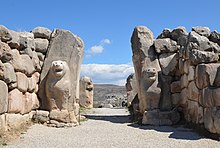Hattuşaş (Turkish) | |
 The Lion Gate in the south-west | |
| Location | Near Boğazkale, Çorum Province, Turkey |
|---|---|
| Region | Anatolia |
| Coordinates | 40°01′11″N 34°36′55″E / 40.01972°N 34.61528°E |
| Type | Settlement |
| History | |
| Founded | 6th millennium BC |
| Abandoned | c. 1200 BC |
| Periods | Bronze Age |
| Cultures | Hittite |
| Site notes | |
| Condition | In ruins |
| Official name | Hattusha: the Hittite Capital |
| Criteria | Cultural: i, ii, iii, iv |
| Reference | 377 |
| Inscription | 1986 (10th Session) |
| Area | 268.46 ha |
Hattusa, also Hattuşa, Ḫattuša, Hattusas, or Hattusha, was the capital of the Hittite Empire in the late Bronze Age during two distinct periods. Its ruins lie near modern Boğazkale, Turkey, (originally Boğazköy) within the great loop of the Kızılırmak River (Hittite: Marashantiya; Greek: Halys).
Charles Texier brought attention to the ruins after his visit in 1834. Over the following century, sporadic exploration occurred, involving different archaeologists. In the 20th century, the German Oriental Society and the German Archaeological Institute conducted systematic excavations, which continue to this day.[1] Hattusa was added to the UNESCO World Heritage Site list in 1986.
- ^ Gates, Charles (2011). Ancient cities: the archaeology of urban life in the ancient Near East and Egypt, Greece and Rome (2nd ed.). London: Routledge. p. 145. ISBN 978-0-203-83057-4.
